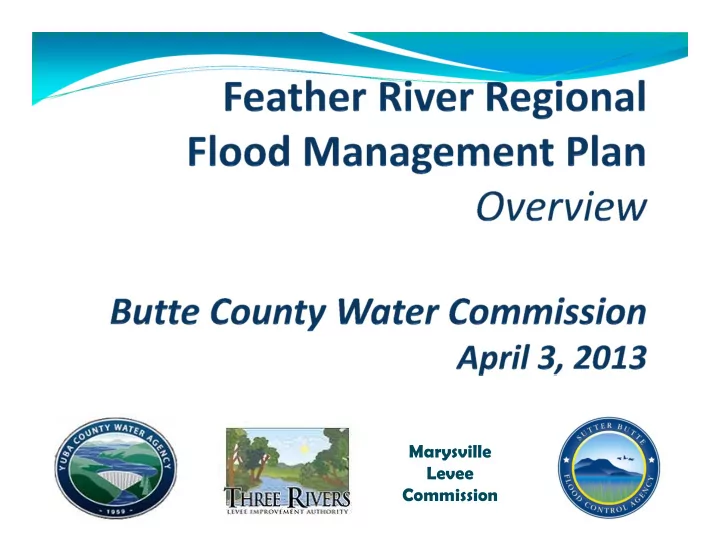

Marysville Levee Commission
Background 2012 Central Valley Flood Protection Plan Regional Flood Management Plans Basin ‐ wide Feasibility Studies 2017 Central Valley Flood Protection Plan
Feather River Regional Boundary
Memorandum of Understanding Partner Agencies: Sutter Butte Flood Control Agency (SBFCA) Marysville Levee Commission (MLC) Three Rivers Levee Improvement Authority (TRLIA) Yuba County Water Agency (YCWA) Marysville Levee Commission
Feather River Regional Flood Management Plan Purpose: Build upon the CVFPP by obtaining more region ‐ specific information and local input for long term implementation of a sustainable and integrated flood risk reduction program in the Central Valley Duration: 18 months Budget: $1.1M
Feather River Regional Stakeholders • 4 Counties – Sutter, Yuba, Butte, and Placer • 6 Cities – Yuba City, Live Oak, Biggs, Gridley, Marysville, and Wheatland • 3 Flood Control Agencies – Sutter Butte Flood Control Agency (SBFCA), Three Rivers Levee Improvement Authority (TRLIA), and the Yuba County Water Agency (YCWA) • 9 LMAs – RD’s 10, 784, 817, 2103, 1001, LD 1, LD 9, and the Sutter Yard (MA 5, 7, 13, & 16) TE1 • 2 Small Communities – Rio Oso and Nicolaus • 21 Currently identified Stakeholder Groups – Including Farm Bureau, Growers, Enterprise Rancheria, Environmental groups/NGOs, Water groups, Chambers of Commerce, Schools, Building and Realty groups, and Citizen and Neighborhood associations
Slide 6 TE1 Only 8 listed - missing Marysville Levee District Thomas Engler, 4/2/2013
Coordinating Committee Steve Lambert primary; Bill Connelly alternate (SBFCA/Yuba City) James Gallagher primary; TBD alternate (SBFCA/Sutter County) Dave Lamon primary; Al Montna alternate (SBFCA/LMAs) Mary Jane Griego primary; John Nicoletti alternate (YCWA/TRLIA/Yuba County) Patrick Ajuria primary; Jerry Crippen alternate (Marysville Levee District) Roger Abe primary; Sardeep Atwal alternate (YCWA/Yuba County) TE2 Agency Staff: Curt Aiken, Robert Bendorf, Paul Bruner, Mike Inamine
Slide 7 TE2 Aikens, not Aiken Thomas Engler, 4/2/2013
Feather River RFMP Team MBK Engineers – Program Management GEI – Plan Formulation and Engineering Downey Brand – Strategic Planning and Legal Kim Floyd Communications – Public Outreach Seth Wurzel Consulting – Finance Plan Environmental & Agricultural Team ICF International – Team Lead Ascent Environmental, HDR, H.T. Harvey, Westervelt, and CBEC
Planning Approach Hazards Consequences Actions and projects to address risk Priorities Residual Risk and Floodplain Management O&M Emergency Response Planning Land Use and Environmental Enhancement Financial Plan
Key Elements Urban Flood Management Projects Alternatives to meet FEMA 100 ‐ year requirements for Small Communities Rural Levee Repairs Non ‐ structural measures and improved emergency response Agricultural preservation Ecosystem enhancement, including evaluation of environmental enhancements through agricultural TE3 modifications TE4 Coordination with parallel system ‐ wide planning by DWR Local, state and federal financing
Slide 10 TE3 Suggest revising "...through agricultural preservation and/or modifications." Thomas Engler, 4/2/2013 TE4 Suggest either Basin-wide or System Improvements so as not to confuse with SWIFs. SWIFs are not funded by the State. Thomas Engler, 4/2/2013
Regional Considerations Coordination with System ‐ wide improvements being TE5 studied by both the Regional agencies and DWR Data gaps in rural and small community areas How do we effectively engage the Public Evaluate how agriculture can be integrated to achieve TE6 habitat objectives of the CVFPP
Slide 11 TE5 Suggest either Basin-wide or System Improvements so as not to confuse with SWIFs. SWIFs are not funded by the State. Thomas Engler, 4/2/2013 TE6 Suggest adding: "while minimizing impacts to agricultural lands." Thomas Engler, 4/2/2013
Outreach Approach Stakeholder identification Feather River Regional Plan website: http://frrfmp.com/ Regional plan hotline: 530 ‐ 845 ‐ 5988 Small ‐ group meetings Planning meetings (governance) Public workshops (3) Updates to Cities/Counties/Resource Agencies Outreach materials (electronic communications)
Financial Plan high level analysis evaluating the financial feasibility TE7 of implementing the identified and prioritized projects Three key steps: Review regional economic setting and growth profile of the region Evaluate potential non ‐ local funding sources Identify and evaluate feasibility of identified local funding sources
Slide 13 TE7 Editorial - capitalize High Thomas Engler, 4/2/2013
Agricultural Preservation & Ecosystem Enhancement Principles Ensuring viable and sustainable agriculture will be a primary component of the RFMP Solutions seek to harmonize achieving habitat objectives of the CVFPP while preserving agriculture, native biodiversity, flood management, recreation, and other existing land uses of the Region Consistency with other habitat planning efforts in the region
Questions?
Financial Plan Funding will be categorized based on short ‐ , medium ‐ , & long ‐ term sources and need Analysis will include General ability of local agencies/beneficiaries to pay (i.e. funding capacity analysis) for short term projects; Identification of medium & long ‐ term potential funding sources; and General ability to fund long ‐ term operations & maintenance. Analysis will not include detailed financing plans for local projects; or LMA specific financial analysis or capability.
Agricultural Preservation & Ecosystem Enhancement: Solutions Holistic resource management approach for land use, flood management, water supply, and habitat Creative partnerships with the farming, environmental, and sportsman communities based on collaborative engagement Combining easements for conservation, flowage, and farming Ag ‐ specific tools: Wildlife ‐ friendly crop types and management techniques “Safe ‐ harbor” agreements to allow continued farm practices Establishing buffers and habitat ‐ rich farm margins Identification of long ‐ term parcel optimization to determine best areas for farming and habitat (similar to habitat conservation plan process) to phase ‐ in preferred use Evaluate enhancement of existing habitat before eva;uating over “new” habitat
Recommend
More recommend